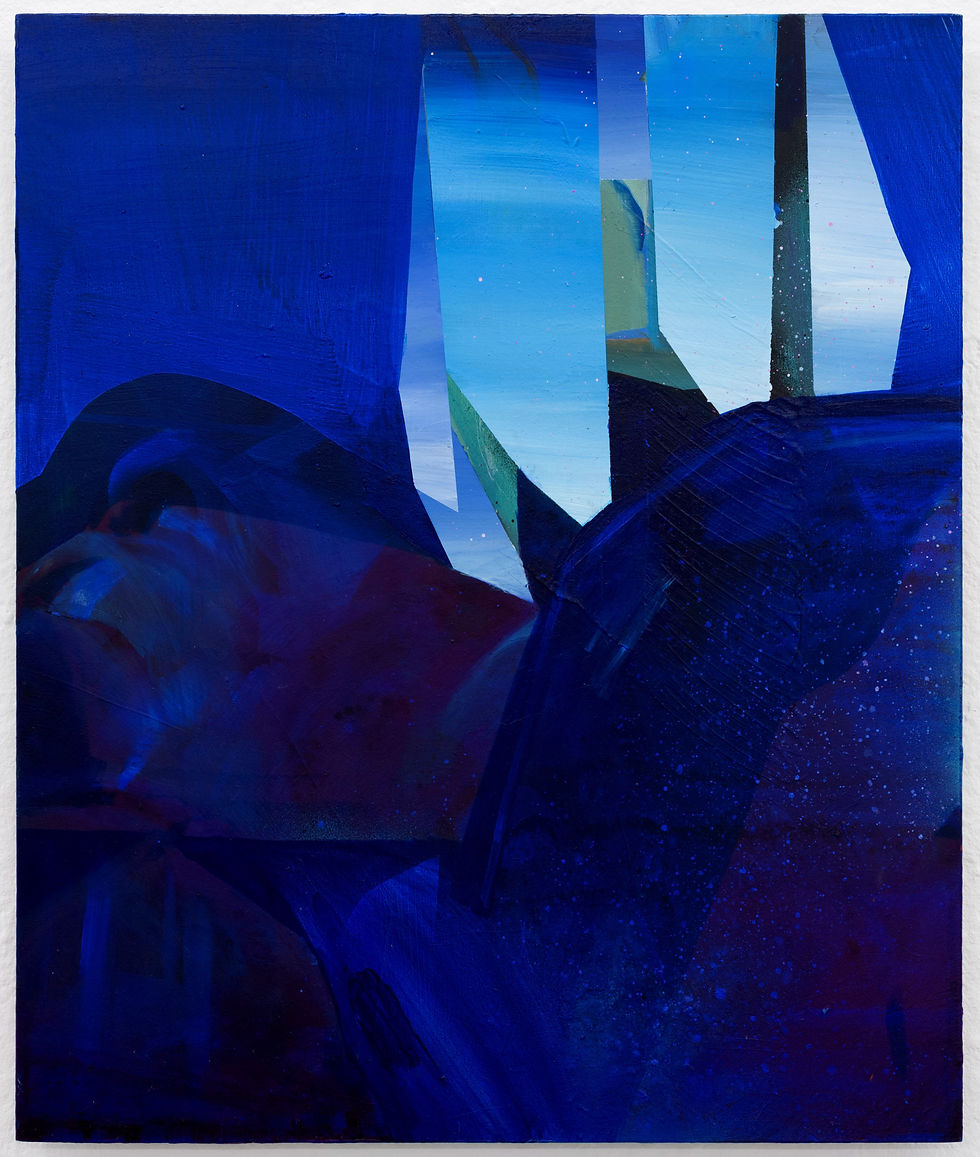
When I met Carolin Israel the first time at the show of graduate students at Kunstakademie Düsseldorf in 2016, she had only very few pictures displayed. However, I was immediately fascinated by her distinctive style. Discover her art, enjoy her pictures, and read my interview with her in which she explains all you need to know about her art.

Carolin was born in Chemnitz, Germany, in 1990. She has completed her Master Degree in Art from Academy of Fine Art, Dresden in 2014. From 2015 to 2016, she studied with Professor Katharina Grosse and Professor Tomma Abts at Kunstakademie Düsseldorf. In 2017, she worked in New York City. She has received numerous grants and prizes, among them the Lucas Cranach Grant of the city of Wittenberg in 2014.
Carolin Israel lives and works in Düsseldorf, Germany.

Carolin and I met again in Frankfurt in April 2017. Here is the interview:
RPR: Carolin, when did you start working as an artist and why?
CI: When I’ve been asked about my future profession back in Kindergarten, I used to say that I want to be an artist, even though I didn’t know what it meant yet. But ever since it has been the path that I felt most comfortable with and worth trying.
After my A levels, I was accepted at the Academy of Fine Arts in Dresden, and I found art as the base as my daily doings and as a journey for the personality as well. But more than this I always have the feeling that I’m working and making progress on something bigger that wants to be discovered.
After graduating it gets way tougher than in the relatively comfortable setting of the academy. I was lucky to have a scholarship in Wittenberg and the next year in Plettenberg, which brought me to the art sphere of institutional educated artists, where I learned a lot and concentrated full time on developing my works. These works (of more concentration) had a high influence in finding my base in the art scene as well. The scholarship allowed me to explore the cities of North Rhine-Westphalia, and as a result, I was able to study in Katharina Grosse’s class at the Art Academy of Düsseldorf and I’m very thankful for that.

RPR: Who and what is inspiring you? Can you think of someone who is influencing you?
CI: For me, when I’m on a dead end in the studio journeys are a great creative impulse. I retain all the images, the atmosphere, and the interesting details I’ve seen and bring them to paper or canvas when I’m back in the peace of my studio when the time to reflect the experiences has come. It’s also a chance to make new friends and connections, which I believe is another big part of the life of an artist.
I’m interested in many different artists and visit art shows as often as I can to learn and progress. But if you asked me to name someone who influenced me recently, it is Katharina Grosse. I was amazed by her open vision of art and questioning way of catching the meaning of an art work and other issues. Things that just need a bit time to be observed to bring forth new thoughts for art.

RPR: Which materials do you work with and which techniques do you prefer?
CI: Mostly I’m working in layers of acrylic and oil colours as well as some techniques with airbrush and cans. So it’s very seldom that I start my works with a concrete sketch or plan. I usually follow my imagination.
Often, I have to slow down and pause the process of one picture to find the right composition, association, and lines for a theme. That’s the reason why I’m working on many works simultaneously until I feel one is progressed enough and finished. Sometimes I draw as well and use coal and ink on paper.

RPR: Where do you work?
CI: I’m working in a very friendly atmosphere in a shared studio with eight other artists in Düsseldorf.
RPR: What do you want to say with your art?
CI: I want to make an honest statement and to explore the field of painting. My works are supposed to have a visual impact, that invites the viewer to take the time to observe and to develop their own thoughts. A good painting is one you never get tired of beholding, and that keeps challenging you.

RPR: Anything you want to achieve — any goals you would like to mention?
CI: The process itself is the achievement: I wish to expand my art by provoking further questions and thoughts; to invite others to be open, to see new things, and to look at allegedly familiar things in different ways.
I’m continuing my search for new forms and diverse ways to connect trough my art. I want my paintings to be as clear as possible even when I’m working with vague images.
RPR: Thank you very much, Carolin.
See all of Carolin Israel’s artwork on her website www.carolin-israel.de
Bbuy selected pieces at RPR ART
This interview has been re-published by www.kunstbar.de.
Learn about art:
Art Historian Ruth Polleit Riechert, PhD, would like to make the opaque art market more transparent for you by publishing her newsletter “Art A-Z”. Don’t miss any of the 26 issues and sign up here. See also her previous posts about “Street Art” (in German), “Printmaking”, “documenta”, “Modern Art”, and “Expressionism”, and “Biennials”.
GET INSPIRED FOR YOUR LIFE: CHOOSE ART.
RPR ART // Dr. Ruth Polleit Riechert // Email: contact@rpr-art.com // Phone: +49 (0)6174-955694
Comentarios